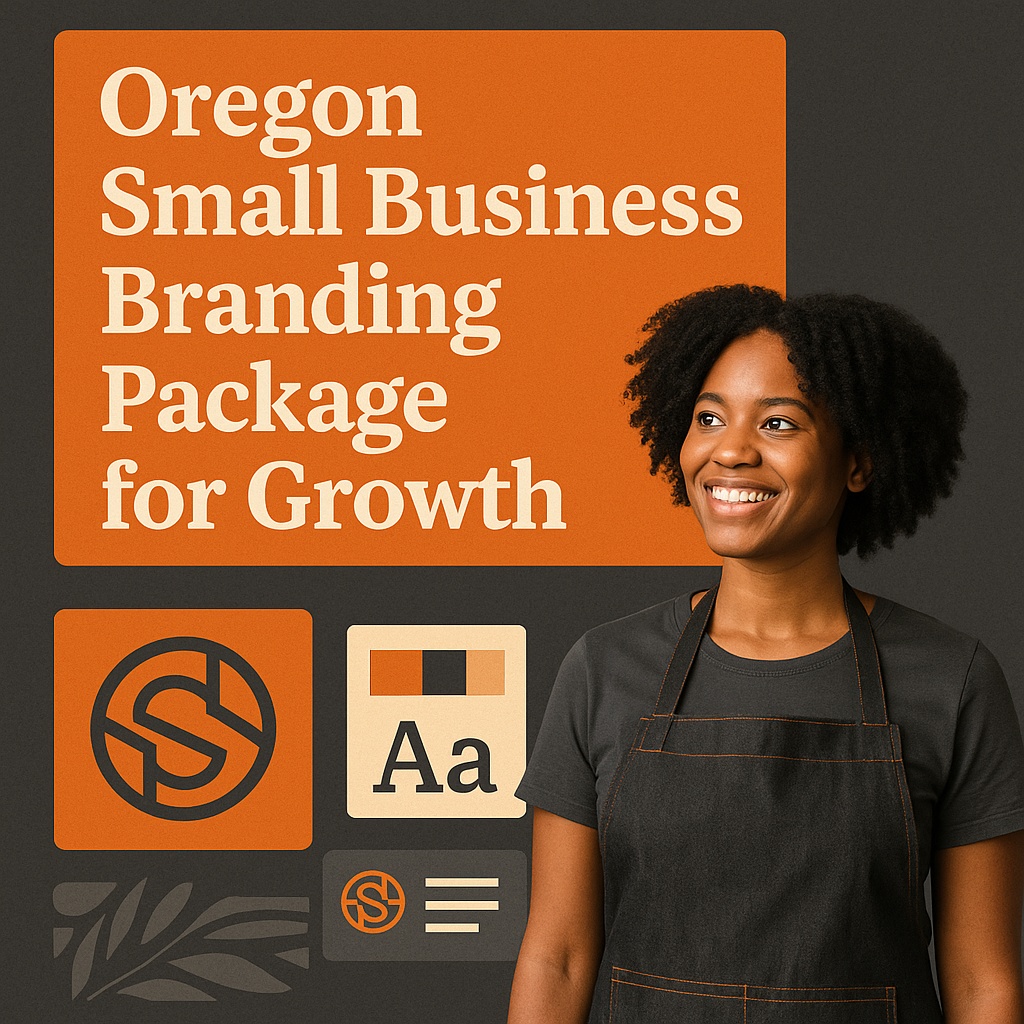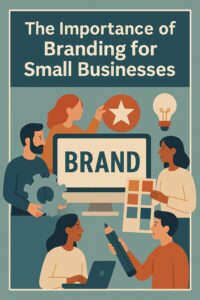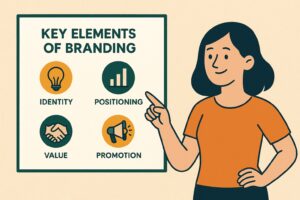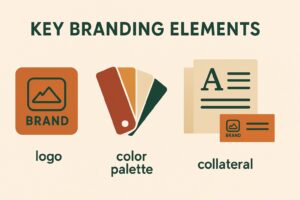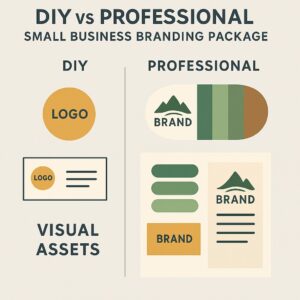A small business branding package is much more than just a logo or a color scheme; it’s a comprehensive toolkit that shapes how your audience perceives you. For small businesses in Oregon, investing in a branding package is essential to not only establish a unique identity but also to connect with your community and customers on a deeper level.
Oregon’s business scene is diverse, featuring everything from artisan shops to tech startups, and the challenges you face are unique. You’re competing with established local brands while also navigating the intricacies of digital marketing. This is where effective branding comes into play. Strong branding helps you differentiate yourself, build trust, and foster loyalty among customers who value authenticity.
Consider that you’re vying for attention in a busy marketplace. An cohesive branding strategy captures your essence while clearly communicating what sets you apart. It steps beyond mere aesthetics—it’s about crafting a memorable experience for your customers, guiding their perception, and encouraging them to choose your business over others.
A well-defined branding package addresses these local challenges head-on. It provides you with a unified visual identity, strategic messaging, and essential marketing tools tailored specifically to your target audience. By investing in professional branding, you not only enhance your online presence but also create lasting impressions that drive growth and engagement.
Explore more branding insights for Oregon businesses
Understanding Small Business Branding
Small business branding is all about crafting a unique identity that resonates with your audience and sets you apart in the crowded marketplace. It’s not just about having a cool logo or catchy tagline; it’s a strategic process that builds trust, differentiation, and loyalty with your customers.
Branding encompasses several key elements that are vital for any small business, especially in Oregon’s diverse economic landscape:
- Logo: This is often the first impression people will have of your business. Your logo should be memorable and communicate the essence of what you do. In a state known for creativity, your logo needs to reflect not just your business type but also your values and identity.
- Color Palette: Colors evoke emotions. Choosing the right colors for your brand can significantly influence how customers perceive you. For instance, greens might convey a sense of sustainability, a vital consideration in eco-conscious Oregon.
- Typography: This aspect of branding isn’t just about fonts; it’s about setting the tone of your communication. The right typography speaks to your audience and reinforces your brand personality. Whether it’s modern and sleek or warm and inviting, your choice should align with your brand’s voice.
- Voice: Your brand voice represents the personality of your business. It’s how you communicate with your customers across all platforms. In Oregon, where many consumers value authenticity and connection, a genuine and relatable voice can foster strong relationships.
In an environment where small businesses are competing with larger, established players, these branding elements become critical. They’re your tools in creating a narrative that resonates with local customers, allowing you to stand out amidst the competition. By establishing a clear brand identity, you not only facilitate customer recognition but also cultivate trust—a key component in driving loyalty.
Think of branding as your business’s personality. It not only helps people remember you but also shapes their expectations and perceptions. Get it right, and you’ll foster a lasting connection with your audience, turning one-time buyers into lifelong customers. In a state where community matters, your brand can become an integral part of your customers’ lives, contributing to the local fabric and enriching the overall customer experience.
See examples of effective branding packages
Key Components of a Small Business Branding Package
A small business branding package typically includes several essential elements that work together to create a cohesive identity. Think of it as a toolkit designed to help your business stand out and convey its unique value to customers. Here’s a breakdown of what you can expect in a comprehensive branding package:
- Logo Design: Your logo is the visual cornerstone of your brand. It should be instantly recognizable and reflect the essence of your business. A strong logo conveys professionalism and builds trust with your audience.
- Brand Colors: Color plays a crucial role in how customers perceive your brand. Your color palette should evoke the right emotions and align with your brand’s personality. For example, earthy tones might resonate well in Oregon, where nature is a significant part of life.
- Typography: The fonts you choose affect your brand’s tone. Typography adds character to your messaging and reinforces your brand’s identity. Make sure your font choices are clear, legible, and compatible with your overall brand image.
- Patterns and Graphics: Subtle elements like patterns or unique graphics can enhance your branding materials. These aspects often help in providing a distinct visual texture that supports your overall identity.
- Marketing Collateral: This includes business cards, brochures, and other printed materials. Having a consistent look across all collateral strengthens brand recognition and ensures your marketing efforts are effective.
- Brand Guidelines: These serve as a roadmap for using your branding elements correctly. Clearly defined guidelines ensure consistency across different platforms, whether online or offline. This is vital for maintaining a unified brand presence.
One of the most important aspects is the integration of your logo and website design. Your logo is often the first thing visitors notice on your site, so it needs to harmonize with the overall design. A cohesive branding approach across your website and materials not only solidifies your identity but also enhances user experience. When customers see the same logo, colors, and messaging across various touchpoints, it creates a sense of familiarity that builds trust and encourages engagement.
Investing in a branding package that integrates these components effectively will position your business for growth in Oregon’s unique marketplace. Cohesive branding makes a lasting impression, helping you foster connections with your community. As you work on your brand, keep in mind that every element contributes to the story you want to tell. Build a brand that reflects who you are and what you stand for, and you’ll see the difference it makes in attracting and retaining customers.
Discover top branding agencies in Oregon
| Element | Description |
|---|---|
| Logo | Visual symbol of your brand identity |
| Color Palette | Colors that convey brand emotions |
| Typography | Fonts that reflect tone and readability |
| Patterns & Graphics | Design textures that enhance visual identity |
| Marketing Collateral | Business cards, brochures, etc. |
| Brand Guidelines | Rules for consistent brand usage |
Comparing DIY and Professional Branding Packages
When it comes to branding, small business owners in Oregon often face the choice between DIY options and hiring a professional. Both paths have their advantages and disadvantages. Let’s break down what each option offers so you can make an informed decision that aligns with your business goals and budget.
DIY Branding Kits: Cost-Effective but Limited
DIY branding kits, often available on platforms like Etsy, can seem appealing, particularly for entrepreneurs on a tight budget. Here are some of the pros and cons:
- Pros:
- Cost: DIY kits are generally cheaper, allowing you to save money upfront. Many kits come at a fraction of the cost of professional packages.
- Immediate Access: You can start working on your branding right away, without waiting for a designer’s schedule or timelines.
- Flexibility: You’re in complete control, able to tweak and adjust elements according to your vision without waiting for feedback or approvals.
- Cons:
- Customization Limitations: Most DIY kits offer generic designs that may not accurately represent your unique business identity.
- Quality Variability: Without professional expertise, the final product may lack polish, a downside when establishing credibility in the local market.
- Time-Consuming: Navigating design tools and making choices can take time, potentially diverting you from other vital business activities.
Professional Branding Packages: Tailored for Success
On the other hand, hiring a professional designer or agency can elevate your branding significantly. Consider these points:
- Pros:
- Customization: Professionals tailor designs specifically for your business, reflecting your values, mission, and local culture.
- Expert Quality: Experienced designers bring a higher level of craftsmanship, ensuring your branding looks polished and cohesive.
- Long-Term Value: An investment in professional branding can yield significant returns. Well-designed branding helps build trust, making it easier to attract and retain customers over time.
- Cons:
- Cost: Professional services can be more expensive, often ranging from a few hundred to several thousand dollars, which may be daunting for small businesses.
- Longer Timelines: The process can take longer as you go through design revisions and approvals, which could delay your branding rollout.
If you aim for a strong, memorable brand identity that communicates your business ethos clearly, investing in a professional designer is likely the better route.
Learn how to pick the right branding agency
| Feature | DIY Branding | Professional Branding |
|---|---|---|
| Cost | Low | High |
| Customization | Low | High |
| Time Required | High | Moderate |
| Quality | Variable | High |
| Scalability | Limited | Scalable |
Aligning Choices with Business Goals
Ultimately, the choice between DIY and professional branding depends on your specific needs:
- If you’re just starting out and need a quick, low-cost solution, a DIY kit might suffice—but be cautious of sacrificing quality.
- If you aim for a strong, memorable brand identity that communicates your business ethos clearly, investing in a professional designer is likely the better route.
Consider your audience and the competitive landscape in Oregon. A local brand that resonates with the community stands a better chance of capturing attention. Think about where you want your business to be in a few years. Investing in high-quality branding now can pay off as you look to grow your online presence and customer base.
Pricing and Investment Considerations for Oregon Small Businesses
Understanding how much to invest in branding is crucial for small businesses in Oregon. The price of branding packages can vary widely based on several factors, including the complexity of the design, the reputation of the designer or agency, and the specific needs of your business. Here’s a breakdown of what you can expect in terms of pricing, timelines, and return on investment.
Typical Pricing Ranges
Branding packages generally range from $300 to $15,000 or more. Here’s how these ranges typically break down:
- Entry-Level Packages ($300 – $1,500): These often include basic logo designs and simple brand elements, suitable for startups or businesses with tight budgets.
- Mid-Tier Packages ($1,500 – $5,000): In this range, you can expect more comprehensive offerings, including branding guidelines, color schemes, and typography. These packages are designed for small businesses that want to establish a professional look.
- High-End Packages ($5,000 – $15,000+): Here, you get an all-inclusive service. Expect custom graphics, detailed brand strategies, and perhaps even consultation services. This option is great for businesses aiming for a robust brand presence in their market.
Value-based pricing means viewing branding as an investment that can generate significant ROI by building trust, loyalty, and clarity in your market.
Breakdown of branding costs and ROI
Average Project Timelines
Alongside pricing, it’s important to understand the timeline for your branding project:
- Entry-Level Projects: Typically take 1-2 weeks to complete, as the design process is straightforward.
- Mid-Tier Projects: Usually require 3-6 weeks, allowing for revisions and feedback to shape the branding elements more finely.
- High-End Projects: These can last anywhere from 1-3 months depending on the complexity and depth of the branding strategy.
As you decide on your budget, think about the timeline that aligns with your business goals. If you’re launching soon, a faster turnaround might be necessary, but investing the time can lead to a more polished brand.
Value-Based Pricing Strategies
It’s essential to see branding as an investment rather than just a cost. Many business owners in Oregon engage in discussions on platforms like Reddit, sharing insights on how much they allocate for branding within their overall marketing budgets. A general guideline suggests that 10% or more of your revenue should go toward marketing efforts, including branding.
Here are a few things to consider:
- Long-Term Value: Well-executed branding can lead to increased customer loyalty and trust, making it easier to attract and retain clients.
- Return on Investment: Businesses often see a significant return on their branding investment, especially if it helps them clearly articulate their value proposition, resulting in more sales and higher customer retention.
- Market Trends: It’s also wise to observe what competitors are investing in branding and how that correlates with their success. Insight from community data can guide your funding strategy for branding.
Ultimately, consider what branding means for your business in the long term. The right investment can set the tone for your customer interactions and distinguishes you from the competition in Oregon’s vibrant market. Without a doubt, choosing the right branding package will be one of the most pivotal decisions for your small business.
| Tier | Price Range ($) | Deliverables |
|---|---|---|
| Entry-Level | $300 – $1,500 | Basic logo & minimal assets |
| Mid-Tier | $1,500 – $5,000 | Comprehensive visual identity & guidelines |
| High-End | $5,000 – $15,000+ | Full strategy, graphics, consultation |
| Package Type | Estimated Time | Details |
|---|---|---|
| Entry-Level | 1-2 weeks | Quick turn-around, limited scope |
| Mid-Tier | 3-6 weeks | Includes revisions, broader assets |
| High-End | 1-3 months | Custom strategy, phased execution |
Step-by-Step Guide to Choosing the Right Brand Designer or Agency
Choosing the right brand designer or agency can feel daunting, especially for a small business owner. However, making the right choice is crucial for your branding success. Here’s how you can navigate the process, evaluate options, and find a designer who aligns with your vision.
1. Evaluate Portfolios
Start by reviewing the designer’s or agency’s portfolio. Look for:
- Style and Quality: Does their style resonate with your vision? Look for quality and creativity in their previous work.
- Diversity of Projects: Check if they’ve worked with businesses similar to yours. A designer with experience in your industry will better understand your needs.
- Results: Seek testimonials or case studies. Understanding how their design impacted clients can help you gauge potential effectiveness for your brand.
2. Understand Deliverables
Make sure you’re clear about what’s included in the branding package. Look for:
- Comprehensive Offerings: A good package should include logo design, color schemes, typography, and brand guidelines.
- Revisions: Find out how many revisions are included. It’s important to have room for adjustments during the creative process.
- Additional Resources: Some designers offer marketing collateral or templates. These can save you time and ensure consistency in your branding.
3. Assess Collaboration Process
The way a designer collaborates with you can greatly impact the outcome. Consider:
- Communication Style: Ensure their communication style suits yours. You need to feel comfortable discussing your ideas and providing feedback.
- Project Management: Ask about their process for managing projects. How will they keep you updated? Will you have regular check-ins?
- Flexibility: Can they adapt to changes or new ideas that arise during the project? A designer who is open to collaboration can produce better results.
4. Clarify Timelines
Knowing the timeline upfront can help you plan better. Inquire about:
- Project Duration: Get a clear estimate of how long the branding project will take, including time for revisions and feedback.
- Milestones: Discuss key milestones in the project. Setting these will help keep both you and the designer accountable.
- Timeliness: Ask how they handle delays. A designer with a solid backup plan can give you peace of mind.
5. Set Communication Expectations
Effective communication is key to a successful branding experience. Discuss the following:
- Preferred Communication Channels: Will you communicate via email, phone calls, or video chats? Make sure you’re on the same page.
- Response Times: Understand how quickly you can expect responses. Quick responses can ease any concerns during the process.
- Feedback Process: Clarify how they prefer to receive feedback. A structured feedback process can help streamline communication and improvements.
6. Ask the Right Questions
When interviewing potential designers, ask questions that reveal their experience and approach:
- What is your design process like? This will help you understand how they approach projects.
- Can you provide references or testimonials from past clients? Hearing from previous clients can give you confidence in their abilities.
- How do you handle disagreements during the design process? Knowing how they deal with conflict will provide insights into their professionalism.
7. Spot Red Flags
Be aware of potential warning signs in your search:
- Lack of Portfolio: If they can’t showcase previous work, it’s a red flag.
- Poor Communication: Slow responses or unclear answers can lead to frustration down the line.
- Unrealistic Promises: If they guarantee results that seem too good to be true, approach with caution.
Choosing the right brand designer or agency is an important step for your business in Oregon. By evaluating portfolios, understanding deliverables, and asking the right questions, you equip yourself with the knowledge to make an informed decision. Each step you take in this process brings you closer to solidifying a brand that resonates with your community and elevates your business presence.
Small Business Branding Tips and Best Practices
When it comes to small business branding in Oregon, consistency and authenticity are key. Here are some practical tips that can help you craft a strong brand identity and grow your online presence.
Maintain Consistency Across All Platforms
Ensuring consistent branding is foundational to building recognition. Your logo, color palette, and messaging should remain uniform across websites, social media, and printed materials. Here’s how:
- Create a Brand Style Guide: Document your branding components, including logos, colors, typography, and tone of voice. This guide will help maintain uniformity across various platforms.
- Use the Same Visual Assets: Whether it’s your Facebook page, Instagram account, or business cards, ensure that the same logos and colors are used everywhere.
- Consistent Messaging: Your brand voice should reflect your business values consistently. Whether you’re posting on social media or responding to customer inquiries, the tone should feel cohesive.
Involve Your Customers in Feedback Loops
Your customers are an invaluable resource in shaping your brand. Involving them in your branding process can lead to a stronger connection and loyalty:
- Surveys and Polls: Use simple surveys to gather feedback on your branding elements. This can include preferences on colors, styles, or even logo options.
- Social Media Engagement: Engage with your audience on social platforms by asking for their opinions on branding ideas. This interaction increases your authenticity and shows you value their input.
- Test Groups: Consider forming focus groups with loyal customers. Their insights on your brand can highlight strengths and areas for improvement.
Leverage Local Cultural Elements for Authenticity
Embedding local culture into your branding can resonate more deeply with your audience:
- Local Imagery: Incorporate images or themes that reflect Oregon’s unique landscapes, wildlife, or cultural aspects. This can help your brand feel more relatable and grounded.
- Support Local Causes: Engage with community initiatives or charities that reflect your brand values. Associating your brand with local efforts can strengthen ties with your customer base.
- Regional Language: Adapt your messaging to reflect local vernacular or idioms. This can make your brand feel more accessible and relatable to Oregonians.
Strategically Update Branding as Your Business Grows
As your business evolves, so too should your branding. Here’s how to make meaningful updates without losing your core identity:
- Monitor Trends: Keep an eye on design trends in your industry. Regularly assess if your branding feels fresh or needs a tweak to stay relevant.
- Gather Customer Feedback: Revisit feedback mechanisms regularly. If your customers voice concerns about your branding’s relevance or appeal, take it seriously.
- Gradual Changes: When making adjustments, do so gradually to maintain customer recognition. Small tweaks can refresh your branding without alienating your existing customers.
By applying these actionable tips, you’ll not only strengthen your brand identity but also cultivate lasting relationships within your community. Strong branding fosters loyalty and encourages customers to choose you over competitors, especially in Oregon’s diverse marketplace. Remember, your brand is more than just visuals; it’s about the experiences and connections you create with your audience.
Showcase of Oregon Small Business Branding Examples
Seeing real-world examples can inspire you and provide valuable insights into how effective branding works in practice. Here, we’ll explore several Oregon small businesses that have successfully implemented their branding packages, achieving unique identities and meaningful customer connections.
1. Blue Star Donuts
Located in Portland, Blue Star Donuts is known for its gourmet donuts and vibrant branding strategy. Their branding package features:
- Bright Color Palette: The use of vivid blues and yellows not only reflects their fun and playful product offerings but also makes their store and packaging instantly recognizable.
- Custom Typography: A unique, hand-drawn typeface adds to their artisanal appeal, aligning perfectly with the brand’s focus on high-quality, handmade treats.
- Community Engagement: Their branding extends to community initiatives, reinforcing their connection to the local customer base while supporting regional causes.
As a result, Blue Star Donuts has built a loyal following, demonstrating how a cohesive brand can drive customer engagement and loyalty.
2. Deschutes Brewery
Deschutes Brewery, a well-known name across the U.S., started as a local craft brewer in Bend, Oregon. Their branding package is a prime example of authenticity:
- Rustic Design Elements: Incorporating imagery that reflects Oregon’s natural beauty—mountains, rivers, and forests—into their labels and advertising connects them deeply to their roots.
- Storytelling: Their branding communicates rich narratives around the brewing process and community involvement, which resonate with customers who value local craftsmanship.
- Consistent Branding: Whether online or in-store, Deschutes Brewery maintains consistency in their logo, color scheme, and messaging, reinforcing their brand identity.
The clear identity helps cultivate a strong emotional connection to their products, which has greatly aided in their growth beyond local borders.
3. Pendleton Woolen Mills
Pendleton Woolen Mills exemplifies how heritage branding can invigorate a modern market. Their branding strategy emphasizes:
- Heritage Colors and Patterns: Pendleton celebrates its long-standing history with designs that reflect Native American artistry, tapping into regional culture.
- Artisan Quality: High-quality materials and craftsmanship are showcased in their branding visuals, reinforcing an image of durability and luxury.
- Community Focus: Engaging with the local community and supporting causes relevant to their heritage enriches their brand narrative.
Pendleton’s branding not only attracts customers interested in quality products but also creates a sense of pride among local residents.
4. Ecliptic Brewing
Based in Portland, Ecliptic Brewing has a strong brand identity that resonates with both craft beer enthusiasts and casual drinkers. Key branding components include:
- Celestial Theme: Their branding is built around a space and celestial theme that connects the art of brewing to exploration, curiosity, and adventure.
- Eye-Catching Labels: Each beer features distinctive labels that reflect their unique flavors, making them stand out on store shelves and in pubs.
- Brand Consistency: The theme carries through all marketing efforts, from their website to social media, creating a cohesive and approachable brand voice.
This consistency and creativity allow Ecliptic Brewing to foster a community of loyal customers who appreciate both the product and the story behind it.
5. Little Green Pickle
Little Green Pickle is a catering business based in Eugene that focuses on sustainable and locally sourced ingredients. Their branding encompasses:
- Earthy Color Tones: The use of greens and browns in their branding reflects their commitment to sustainability and fresh ingredients.
- Clear Messaging: Their branding communicates a strong environmental stance, appealing to eco-conscious consumers looking for sustainable catering options.
- Personal Touch: Incorporating local farmers and with whom they work emphasizes community support and connection, creating a narrative that resonates in their branding.
Little Green Pickle has successfully carved out a niche by aligning its brand identity with the values of its target audience, proving effective branding can enhance local relevance and customer loyalty.
These examples illustrate the power of a well-crafted branding package. Each of these Oregon businesses employed different strategies tailored to their unique offerings and target audiences, yet all succeeded in creating distinctive identities that resonate within their communities. By studying these brands, you can gain insights and inspiration for your own branding journey, reinforcing the importance of local relevance in building a strong brand identity.
Implementing Your Branding Package Online and Offline
Once you’ve invested in a comprehensive branding package, the next crucial step is effective implementation. This means taking the elements—your logo, color palette, typography, and overall design—and applying them consistently across both online and offline channels. Here’s how you can create a unified brand experience that resonates with your audience and drives engagement.
Online Implementation Strategies
In the digital world, your online presence is often the first interaction a customer has with your brand. Here’s how to make that impression count:
- Your Website: This acts as your digital storefront. Ensure that your branding package is reflected in every aspect of your website—from the logo and color scheme to typography and imagery. Use your brand guidelines to maintain consistency across all pages, creating a seamless user experience that aligns with your brand identity. Your website should tell your brand story effectively, emphasizing what makes your Oregon-based business special.
- Social Media: Social platforms are a vital extension of your brand. Use your branding elements in profile images, cover photos, and post graphics. Develop a consistent posting style that reflects your brand voice, and consider creating templates for social media posts to ensure uniformity in aesthetic and messaging. Engaging with your audience in a tone that aligns with your brand values builds a stronger community around your business.
- Email Marketing: When sending out newsletters or promotional emails, embed your branding so recipients immediately recognize who you are. Use your color palette and logo in headers, footers, and body text. Consistent branding in emails reinforces brand recognition and keeps your business top of mind for customers.
Offline Implementation Strategies
While your online presence is critical, offline branding should not be overlooked. Here’s where you can take your branding beyond the screen:
- Packaging: If you sell products, ensure your packaging reflects your brand identity. Use your logo and brand colors to create packaging that customers can recognize instantly. Clever packaging can also enhance the unboxing experience, turning a mundane task into a memorable moment.
- Signage: Whether it’s a storefront sign or directional signs at a local event, your signage should reflect your brand. Clear, consistent design elements will help potential customers identify your business quickly and create a cohesive visual experience that echoes across various touchpoints.
- Business Cards: Don’t underestimate the power of a well-designed business card. Use your branding package to create a professional-looking card that leaves a lasting impression. Make sure your card not only includes your logo and color scheme but also captures the essence of your brand’s personality.
Creating a Unified Brand Experience
For your branding to be effective, consistency is key. Here are some tips to ensure that every element works harmoniously:
- Brand Style Guide: Create a comprehensive style guide that outlines how all branding elements should be used. This includes logos, fonts, colors, and tones of voice. It acts as a reference to maintain consistency no matter who is creating content or materials.
- Regular Audits: Periodically evaluate your branding across all channels. Are your online and offline materials consistent? If not, adjust and unify your approach to maintain a cohesive brand identity.
- Foster Employee Buy-In: Ensure that your team understands and embodies your brand. Training your staff on your brand values and communication style can turn them into your best brand ambassadors, creating a consistent brand experience for customers.
Implementing your branding package effectively, both online and offline, will solidify your identity, build trust with your audience, and enhance customer loyalty. Consistency across all channels not only makes your business recognizable but also creates an emotional connection with your customers. By aligning your branding efforts across various platforms and materials, you’ll forge a strong, cohesive presence that resonates within the Oregon market and sets you up for sustainable growth.
Conclusion and Call to Action
In the competitive landscape of small business, having a well-crafted branding package is crucial for your success. It’s not just about creating a pretty logo or choosing a color scheme; it’s about establishing a consistent identity that builds trust and resonates with customers. For small businesses in Oregon, this means addressing local challenges head-on and fostering connections within your community.
A comprehensive branding package empowers you to present a unified front, ensuring every element—from your logo to your messaging—aligns with your business goals. It sets the stage for forging meaningful relationships with customers who value authenticity and connection.
Now, it’s time for you to assess your branding needs. Does your current branding communicate your unique value? Are your visuals and messaging consistently reflecting your mission? If you’re unsure or feel that your brand could use a refresh, don’t hesitate to reach out to professional brand designers or agencies. They can guide you in crafting a tailored branding package that meets your specific needs and elevates your online presence.
Take the first step towards a stronger brand identity today. Contact Nesace Media to build a custom branding package that drives visibility, trust, and growth for your Oregon small business.

